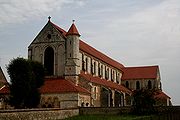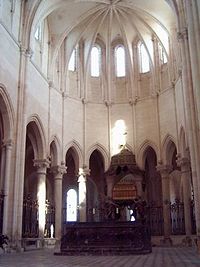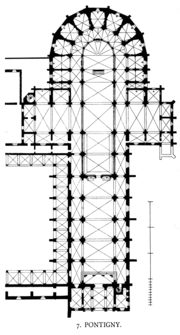
Pontigny Abbey
Encyclopedia



Cîteaux Abbey
Cîteaux Abbey is a Roman Catholic abbey located in Saint-Nicolas-lès-Cîteaux, south of Dijon, France. Today it belongs to the Trappists, or Cistercians of the Strict Observance . The Cistercian order takes its name from this mother house of Cîteaux, earlier Cisteaux, near Nuits-Saint-Georges...
, was a Cistercian monastery situated in the commune of Pontigny
Pontigny
Pontigny is a commune in the Yonne department in Burgundy in north-central France....
, on the River Serein
Serein
The Serein is a river of eastern France. It is the main waterway of the Chablis wine district in Burgundy.-Origin of the name:Serein is the French word for "serene". This may reflect the placid nature of its course, or the strong monastic tradition in the area.-Geography:The Serein rises in the...
, in the present diocese of Sens and department of Yonne
Yonne
Yonne is a French department named after the Yonne River. It is one of the four constituent departments of Burgundy in eastern France and its prefecture is Auxerre. Its official number is 89....
, in Burgundy
Bourgogne
Burgundy is one of the 27 regions of France.The name comes from the Burgundians, an ancient Germanic people who settled in the area in early Middle-age. The region of Burgundy is both larger than the old Duchy of Burgundy and smaller than the area ruled by the Dukes of Burgundy, from the modern...
, France
France
The French Republic , The French Republic , The French Republic , (commonly known as France , is a unitary semi-presidential republic in Western Europe with several overseas territories and islands located on other continents and in the Indian, Pacific, and Atlantic oceans. Metropolitan France...
.
History
Hildebert (or Ansius), a canon of AuxerreAuxerre
Auxerre is a commune in the Bourgogne region in north-central France, between Paris and Dijon. It is the capital of the Yonne department.Auxerre's population today is about 45,000...
, petitioned Abbot Stephen Harding
Stephen Harding
Saint Stephen Harding is a Christian saint and abbot, one of the founders of the Cistercian Order.-Life:Stephen Harding was born in Dorset, England. He was placed in Sherborne Abbey at a young age, but eventually put aside the cowl and became a travelling scholar. He eventually moved to Molesme...
of Cîteaux to found a monastery in a place he had selected for this purpose. Accordingly in 1114 Saint Stephen sent twelve monks under the guidance of Hugh of Mâcon, the first abbot and a friend and kinsman of Bernard of Clairvaux
Bernard of Clairvaux
Bernard of Clairvaux, O.Cist was a French abbot and the primary builder of the reforming Cistercian order.After the death of his mother, Bernard sought admission into the Cistercian order. Three years later, he was sent to found a new abbey at an isolated clearing in a glen known as the Val...
, to establish the new foundation. Under Abbot Hugh and his successor, Guichard, the new monastery developed such a reputation for sanctity that it attracted sufficient numbers to be able to establish another twenty-two Cistercian monasteries.
Many members of the community of Pontigny went on to occupy high positions in the church and many distinguished personages sought refuge there. Amongst the former were, for example, Blessed Hugh of Mâcon, Bishop of Auxerre (d. 1151); Girard Mainard, Cardinal Bishop of Praeneste (d. 1202); and Robert, Cardinal Titular of St. Pudentiana (d. 1294). The latter included three Archbishops of Canterbury
Archbishop of Canterbury
The Archbishop of Canterbury is the senior bishop and principal leader of the Church of England, the symbolic head of the worldwide Anglican Communion, and the diocesan bishop of the Diocese of Canterbury. In his role as head of the Anglican Communion, the archbishop leads the third largest group...
: Saint Thomas a Becket
Thomas Becket
Thomas Becket was Archbishop of Canterbury from 1162 until his murder in 1170. He is venerated as a saint and martyr by both the Roman Catholic Church and the Anglican Communion...
, Stephen Langton
Stephen Langton
Stephen Langton was Archbishop of Canterbury between 1207 and his death in 1228 and was a central figure in the dispute between King John of England and Pope Innocent III, which ultimately led to the issuing of Magna Carta in 1215...
and Saint Edmund of Abingdon
Edmund Rich
Edmund Rich was a 13th century Archbishop of Canterbury in England...
, who was buried there.
Over the centuries, however, the original strict discipline relaxed, especially from 1456, when the abbey was given in commendam
In Commendam
In canon law, commendam was a form of transferring an ecclesiastical benefice in trust to the custody of a patron...
. In 1569 it was pillaged and burnt by the Huguenot
Huguenot
The Huguenots were members of the Protestant Reformed Church of France during the 16th and 17th centuries. Since the 17th century, people who formerly would have been called Huguenots have instead simply been called French Protestants, a title suggested by their German co-religionists, the...
s, only the relics of Saint Edmund being saved. Partly restored, it continued in existence until it was suppressed during the French Revolution
French Revolution
The French Revolution , sometimes distinguished as the 'Great French Revolution' , was a period of radical social and political upheaval in France and Europe. The absolute monarchy that had ruled France for centuries collapsed in three years...
. The monastic buildings were largely destroyed, but the church was saved, due to the respect in which the cult of Saint Edmund was still held, and continued in use after the Revolution as a parish church.
In 1843 a community of the Fathers of St. Edmund was established here by J. B. Muard.
In 1909 the site was bought by the philosopher Paul Desjardins
Paul Desjardins
Paul Desjardins is a former all-star professional Canadian football offensive lineman who played nine seasons in the Canadian Football League.-External links:*...
, who from 1910 to 1914 and from 1922 to 1939 held here every year the so-called "Decades of Pontigny", or conferences of ten days' duration, where the intellectual élite of Europe met including inter alia Antoine de Saint-Exupéry
Antoine de Saint-Exupéry
Antoine de Saint-Exupéry , officially Antoine Marie Jean-Baptiste Roger, comte de Saint Exupéry , was a French writer, poet and pioneering aviator. He became a laureate of France's highest literary awards, and in 1939 was the winner of the U.S. National Book Award...
, Jean-Paul Sartre
Jean-Paul Sartre
Jean-Paul Charles Aymard Sartre was a French existentialist philosopher, playwright, novelist, screenwriter, political activist, biographer, and literary critic. He was one of the leading figures in 20th century French philosophy, particularly Marxism, and was one of the key figures in literary...
, Simone de Beauvoir
Simone de Beauvoir
Simone-Ernestine-Lucie-Marie Bertrand de Beauvoir, often shortened to Simone de Beauvoir , was a French existentialist philosopher, public intellectual, and social theorist. She wrote novels, essays, biographies, an autobiography in several volumes, and monographs on philosophy, politics, and...
, T. S. Eliot
T. S. Eliot
Thomas Stearns "T. S." Eliot OM was a playwright, literary critic, and arguably the most important English-language poet of the 20th century. Although he was born an American he moved to the United Kingdom in 1914 and was naturalised as a British subject in 1927 at age 39.The poem that made his...
, Thomas Mann
Thomas Mann
Thomas Mann was a German novelist, short story writer, social critic, philanthropist, essayist, and 1929 Nobel Prize laureate, known for his series of highly symbolic and ironic epic novels and novellas, noted for their insight into the psychology of the artist and the intellectual...
, Heinrich Mann
Heinrich Mann
Luiz Heinrich Mann was a German novelist who wrote works with strong social themes. His attacks on the authoritarian and increasingly militaristic nature of pre-World War II German society led to his exile in 1933.-Life and work:Born in Lübeck as the oldest child of Thomas Johann Heinrich Mann...
.
Burials
Among the burials in the abbey church are the following:- Adèle of ChampagneAdèle of ChampagneAdèle of Champagne , also known as Adelaide and Alix, was the third wife of Louis VII of France and the mother of his only male heir, the future Philip II...
(1145–1206), queen of Louis VII of FranceLouis VII of FranceLouis VII was King of France, the son and successor of Louis VI . He ruled from 1137 until his death. He was a member of the House of Capet. His reign was dominated by feudal struggles , and saw the beginning of the long rivalry between France and England... - Saint Edmund of Abingdon (c. 1180–1240), Archbishop of Canterbury
- Paul Desjardins (1859–1940)
Viticulture
Next to their religious duties the monks of Pontigny were also much occupied in the cultivation of vineyards. They established the original vineyard from which the present Chablis wine traces its descent.Pilgrims' Route
The abbey is a stopping-point on one of the pilgrimage routes to Santiago de CompostelaSantiago de Compostela
Santiago de Compostela is the capital of the autonomous community of Galicia, Spain.The city's Cathedral is the destination today, as it has been throughout history, of the important 9th century medieval pilgrimage route, the Way of St. James...
.

